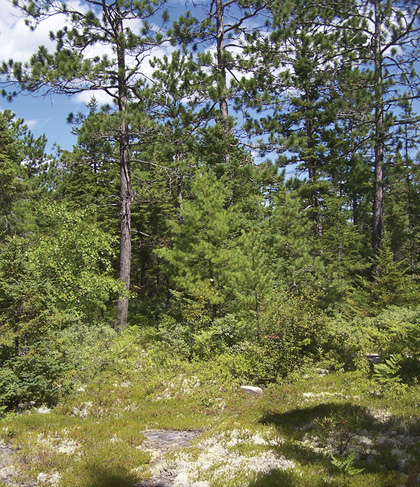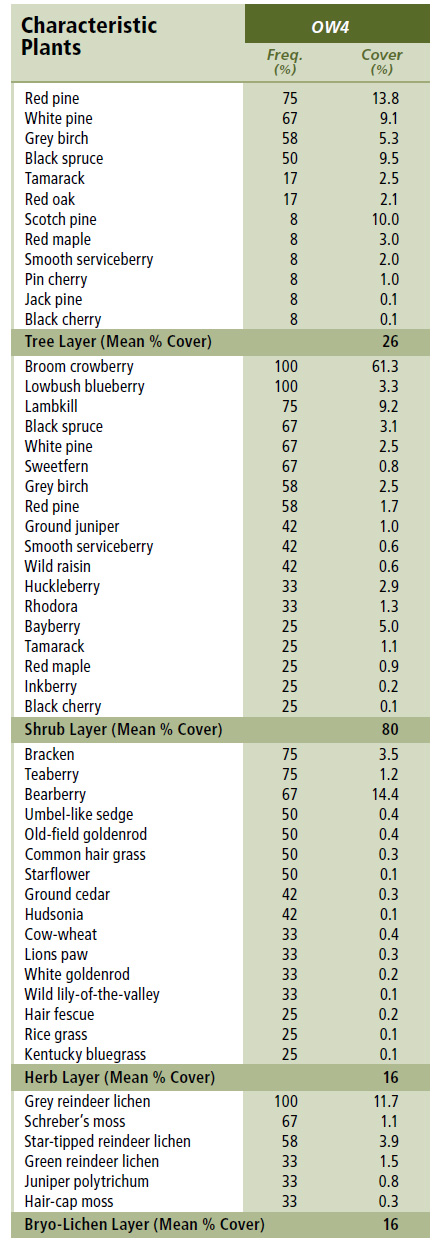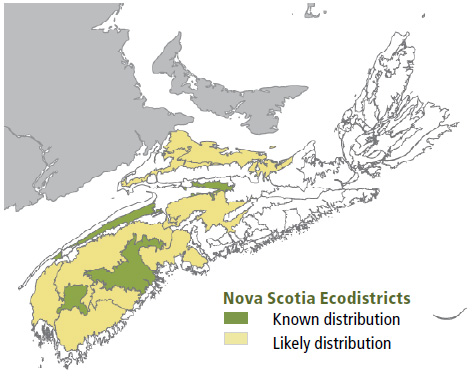
Forest Vegetation types - OW4
OW4 — Red pine – White pine / Broom crowberry / Grey reindeer lichen
Pinus resinosa – Pinus strobus / Corema conradii / Cladina rangiferina
 |
Hibernia, Queens County |
Concept: This sparsely treed coniferous woodland is a transitional successional stage, encompassing species of both open heathland and closed canopy pine forest usually SP2 (Red pine / Blueberry / Bracken). The ecosystem is characterized by low crown closure, frequent red pine, and high broom crowberry cover; reindeer lichens are abundant in some occurrences. The Red pine – White pine / Broom crowberry / Grey reindeer lichen woodland is found on dry sandy or coarse loamy soils with low humus accumulation and reduced nutrient availability. Many occurrences originate with fire.
Vegetation: The open evergreen canopy is dominated by red pine and/or white pine, but the latter condition is less common. On somewhat moister soils, black spruce and/or larch may be prominent, while pine is absent or sparse. Deciduous tree species may be found scattered but most are uncommon. Non-native trees species (e.g. Scotch pine, Black locust) are rapidly spreading in some occurrences and threatening ecosystem persistence. Lower strata are dominated by low shrubs. Broom crowberry is abundant in all occurrences but is typically excluded under denser tree crowns. Herbaceous cover is reduced except near exposed sand and around disturbed sites (i.e. often caused by all-terrain vehicle traffic). Forest species (e.g. wild lily-of-the-valley, starflower, pink lady's slipper, bluebead lily and checkered rattlesnake plantain) occur under tree or tall shrub cover. Reindeer lichen abundance is moderate to high.
Environmental Setting: OW4 is mainly found on dry, sandy, nutrient very poor soils associated with glaciofluvial deposits or shallow, gravelly and/or coarse textured glacial tills. Most soils are deep and well drained but the presence of cemented (orstein) soil horizons in some sites can impede drainage and increase available moisture in the rooting zone. This Vegetation Type (VT) is found in warmer areas and is excluded from the coast. It is found in the Valley and Central Lowlands and Western ecoregions. This VT is nationally, if not globally, unique. It is not found outside Nova Scotia.
Successional Dynamics: This is an early successional woodland community. It is the first treed successional stage expressed in broom crowberry heathland on mainland Nova Scotia. The ecosystem often occurs on the edges of open barrens as a transition to closed forest. In other sites, trees may be more evenly and widely scattered. Fire is a component of stand history in most occurrences, but long-standing fire suppression programs have promoted higher tree presence, contributing to the loss of open broom crowberry heathland. In the absence of fire or other disturbances, the woodland will succeed to SP2 (Red pine / Blueberry / Bracken).
Ecological Features: Global occurrences of this provincially uncommon ecosystem are limited to Nova Scotia. The often sandy small patch woodland's most remarkable features include its rarity, restricted distribution, and relatively specific environmental requirements (including a potential dependency on fire for establishment and maintenance). These collectively contribute to OW4's high vulnerability, which presents unique conservation challenges. Unlike some of the other rare woodlands in Nova Scotia (e.g. OW1, OW2 and OW5) many occurrences of this ecosystem are critically threatened by human activities, including aggregate mining, commercial and residential development, fire suppression and some types of logging. OW4 supports extraordinarily unique habitat conditions, but most associated species are undocumented. Some exceptions include: vesper sparrow, arrowleaved violet, Case's ladies'-tresses, Canada mountain-ricegrass, rock-rose, pine barren goldenheather and dixie reindeer lichen. Many of these are species of high conservation concern.
 |
| Broom crowberry |
Distinguishing Features: This softwood woodland is characterized by open growing red pine. Broom crowberry is abundant but is typically excluded under denser tree crowns. Soils are very dry and sandy. Reindeer lichen can be extensive.
| Slope Position: | Level8 Middle1 Upper1 |
Surface Stoniness: |
(Non - Slightly)4 (Very - Excessively)2 (Moderately)1 nd3 |
Bedrock Outcrop: |
(Non-rocky)5 (Very - Excessively)1 nd4 |
Elevation Range: |
10 - 140m |
Slope Gradient: |
Level8 Gentle2 |
Aspect: |
South1 None8 nd1 |
Exposure: |
Moderate4 Mod. exposed1 nd5 |
Microtopography: |
Level3 Slightly2 Moderately1 nd4 |
Drainage: |
Well4 Rapid2 nd4 |
Soil Type: |
ST14 ST152 nd4 |
Parent Material: |
Glaciofluvial8 Glacial till2 |
Rooting Depth (cm): |
(<30)2 (30-45)2 (>45)1 nd5 |
Duff Thickness (cm): |
(6-10)3 (11-20)2 nd5 |

